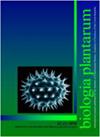LICC1的微管相互作用,LICC1是人类滑鼠蛋白/RanBPM/CTLH蛋白复合物一种成分的玉米同源物
IF 0.9
4区 生物学
Q4 PLANT SCIENCES
引用次数: 0
摘要
MRCTLH (muskelin/RanBPM/CTLH)是一种在人类中发现的蛋白质复合物(MRCTLH),它参与许多细胞过程的调节,如糖异生、细胞信号传导、发育、核挤压、细胞形态或不同蛋白质的稳定性。根据基因组数据,所有真核生物都有相似的蛋白质复合物。在酵母中,一种名为GID的类似蛋白质复合物被发现参与糖异生的调节。LICC1是一种玉米蛋白,其序列类似于人类中的TWA1和酵母中的GID8,它们是MRCTLH和GID复合物的核心成分。LICC1包含三个高度保守的蛋白结构域,即LisH、CTLH和CRA,是该蛋白家族的典型结构域。Twa1和gid8是人类和酵母基因组中独特的基因。然而,licc1在玉米基因组中有3个拷贝,在其他植物基因组中有多个拷贝。这一结果表明植物中存在MRCTLH/GID复合体的多个变体,这可能会增加其调控能力。我们在这里也证明了LICC1具有与微管相互作用的能力,类似于人类的TWA1。这种相互作用强化了一种观点,即玉米中的LICC1蛋白及其在植物中的同源物,以及植物中的GID/MRCTLH复合物,可以发挥与人类和酵母相似的生物学功能。本文章由计算机程序翻译,如有差异,请以英文原文为准。
Microtubule interaction of LICC1, a maize homologue of a component of the human muskelin/RanBPM/CTLH protein complex
MRCTLH (muskelin/RanBPM/CTLH) is a protein complex found in humans (MRCTLH) that is involved in the regulation of numerous cellular processes, such as gluconeogenesis, cell signaling, development, nuclear extrusion, cell morphology, or stability of different proteins. According to genomic data, all eukaryotes have similar protein complexes. In yeast, a similar protein complex named GID was found to be involved in the regulation of gluconeogenesis. LICC1 is a maize protein whose sequence resembles that of TWA1 in humans and GID8 in yeast, which are central components of the MRCTLH and GID complexes. LICC1 contains three highly conserved protein domains, LisH, CTLH, and CRA, typical of this protein family. Twa1 and gid8 are unique genes in human and yeast genomes. However, three copies of licc1 are present in the maize genome and multiple copies are present in other plant genomes. This result suggests the presence of multiple variants of the MRCTLH/GID complex in plants, which could increase its regulatory capacity. We also demonstrate here that LICC1 has the ability to interact with microtubules, similarly to the human TWA1. This interaction reinforces the idea that the LICC1 protein from maize, and its homologues in plants and, in general, the GID/MRCTLH complex in plants, can perform biological functions similar to those in humans and yeast.
求助全文
通过发布文献求助,成功后即可免费获取论文全文。
去求助
来源期刊

Biologia Plantarum
生物-植物科学
CiteScore
2.80
自引率
0.00%
发文量
28
审稿时长
3.3 months
期刊介绍:
BIOLOGIA PLANTARUM is an international journal for experimental botany. It publishes original scientific papers and brief communications, reviews on specialized topics, and book reviews in plant physiology, plant biochemistry and biophysics, physiological anatomy, ecophysiology, genetics, molecular biology, cell biology, evolution, and pathophysiology. All papers should contribute substantially to the current level of plant science and combine originality with a potential general interest. The journal focuses on model and crop plants, as well as on under-investigated species.
 求助内容:
求助内容: 应助结果提醒方式:
应助结果提醒方式:


